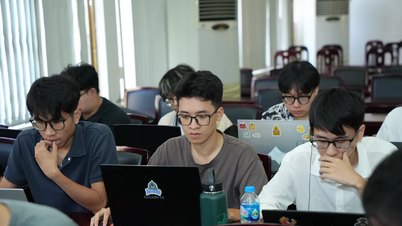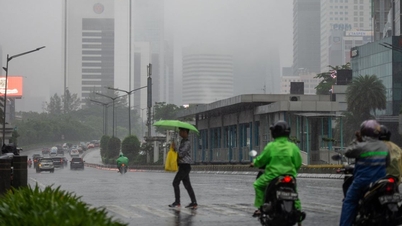The revolution under the sea
In March 2023, off the coast of Lingshui, Hainan Province, China placed a 1,300-ton “data capsule” into the seabed. This is the world ’s first commercial underwater data center, marking a major turning point in the way humans build digital infrastructure. More than just a technological project, the project is also China’s answer to the difficult problem: How to meet the increasingly huge demand for AI computing without falling into a deadlock of energy and fresh water.

Scale model of China's underwater AI data center. (Photo: Ourchinastory)
In the context of the explosion of artificial intelligence, each user query sent to the cloud means electricity consumed and water used to cool server chips. Putting data centers on the seabed is not only symbolic, but may be the inevitable direction for the future of sustainable digital infrastructure.
AI, cloud computing and big data are creating an unprecedented thirst for computing power. Data centers – home to tens of thousands of servers – are the “factories” that provide this computing power. But the price to pay is huge. It is estimated that up to 40% of the electricity consumed by data centers is for cooling alone.
Along with that comes the need for fresh water. A study in the US found that every 20-50 AI queries can consume the equivalent of a 500ml bottle of water. Training GPT-3 once “devoured” more than 700,000 liters of water, enough to produce several hundred cars or supply water to an entire village for weeks.
Ironically, many data centers are being built in arid regions such as Arizona (USA), Spain or the Middle East, where agriculture and people are already struggling due to water shortages. The direct competition between “servers” and “drinkers” makes the resource conflict more obvious.
Putting data centers under the sea
China’s solution sounds like science fiction: Instead of leaving thirsty servers on land, they put them on the sea floor. There, the massive heat is dissipated by natural ocean currents. No cooling towers, no fresh water pumps, just pipes for the seawater to absorb and carry the heat away from the servers.

Shanghai Hailanyun Technology will lower the first phase of its underwater data center into the waters off Hainan in December 2022. (Photo: Shanghai Hailanyun Technology)
In addition to saving energy, this solution also avoids occupying increasingly scarce and controversial land. The sealed environment inside the “data capsule” is also more stable: no dust, no vibration, humidity and pressure are controlled. This significantly reduces the failure rate of the device.
In particular, undersea data centers can easily connect to offshore renewable energy sources, especially wind power. For example, the Shanghai offshore center is designed to get up to 97% of its electricity from an adjacent offshore wind farm. A side benefit is reduced data transmission latency when located near coastal cities, serving industries that need instant data synchronization, such as self-driving cars.
Lingshui, Hainan is the place to mark the historic milestone. In November-December 2023, the first “data capsule” was placed at a depth of more than 40 meters, 3 kilometers from shore. With a capacity equivalent to 60,000 computers, the system can process up to 4 million HD images in just 30 seconds. The design life is 25 years, operating stably even when super typhoon Terry sweeps through in 2023. The long-term plan is to deploy 100 capsules, saving 122 million kWh of electricity per year, 68,000 m² of land and 105,000 tons of fresh water.

The underwater data center pictured is a pilot project off the coast of Hainan. A more advanced project is being built off the coast of Shanghai. (Photo: Shanghai Hailanyun Technology)
In parallel, off the coast of Shanghai, Hailanyun (also known as HiCloud) is implementing a $223 million project. Phase 1 has 198 racks, equivalent to 396 - 792 AI servers, enough to train a GPT-3.5-equivalent model in just one day. Although the scale is smaller than the onshore center (3,000 - 10,000 racks), the project is considered a springboard for a series of underwater data centers, with strong government support.
Lessons from Microsoft Project Natick
Before China, Microsoft was a pioneer. In 2015, the company launched Project Natick, dropping a container containing 800 servers into the sea of Scotland. After two years, the results were surprising: The system operated sustainably, saved energy, and had a failure rate only 1/8 of that of the onshore center. The secret lies in the sealed chamber containing nitrogen gas, eliminating human and environmental impacts.

Microsoft's underwater data center project. (Photo: VCG)
However, Microsoft stopped at the experimental stage, not commercialization. The company only considered Natick as a research platform. Meanwhile, China moved faster: It took only 30 months to turn the idea into a commercial project – a rare “shortcut” in the digital infrastructure industry.
Data is likened to the “new oil”. Whoever controls the computing infrastructure will have an advantage in the digital economy race. Recognizing this, China has included data centers in its list of six “new infrastructure” focuses.
The underwater projects are not only a technical solution to save electricity and water, but also a political statement: China is ready to lead the world in green technology for AI. Hailanyun has openly expressed its ambition to “surpass the US”, expanding its scale with state sponsorship.
Big question marks
Despite its obvious potential, the model is not without controversy. Environmentally, research has shown that seawater near the Natick capsule has risen by several thousandths of a degree. In ocean heatwave conditions, the hot wastewater could deplete oxygen, threatening marine life.
On the security front, a 2024 study warned that a special acoustic signal could damage the underwater capsule, posing a threat of attack. On the technical side, sealing against leaks, corrosion, and biofouling requires precision down to the millimeter.

A design of a wind power plant for an undersea AI data center in Shanghai, China. (Photo: Shanghai Hailanyun Technology)
Hailanyun claims the environmental impact is “negligible” (less than 1°C) and has tackled the parasite in tropical regions. But the international scientific community has called for closer monitoring before scaling up.
China’s early success has sparked a wave of interest. South Korea has announced plans to deploy underwater data centers. Japan and Singapore are studying “floating” variants that can be built on water.
This suggests that the idea is not just a “Chinese specialty” but could become a global trend. However, the speed of its spread will depend more on the maritime legal framework, ecological assessment and supply chain assurance than on pure technical capabilities.
The Future of AI: In the Cloud or Under the Sea?
The underwater data center is a testament to humanity's ingenuity in the face of enormous challenges. It combines three factors: technological need, environmental pressure, and national strategy.
But the road ahead is long: It must prove its safety, economic efficiency, and social acceptance. If successful, the AI of the future will not only “live in the cloud,” but also “reside under the sea” – where ocean currents cool, sea breezes provide electricity, and giant steel capsules silently process trillions of calculations.
China has started the show. Will the rest of the world watch or jump on the bandwagon? The answer will shape the face of global digital infrastructure for decades to come.
Source: https://vtcnews.vn/trung-quoc-xay-trung-tam-du-lieu-ai-duoi-bien-dau-tien-ar964490.html


![[Photo] Closing ceremony of the 18th Congress of Hanoi Party Committee](https://vphoto.vietnam.vn/thumb/1200x675/vietnam/resource/IMAGE/2025/10/17/1760704850107_ndo_br_1-jpg.webp)
![[Photo] Collecting waste, sowing green seeds](https://vphoto.vietnam.vn/thumb/1200x675/vietnam/resource/IMAGE/2025/10/18/1760786475497_ndo_br_1-jpg.webp)
![[Photo] General Secretary To Lam attends the 95th Anniversary of the Party Central Office's Traditional Day](https://vphoto.vietnam.vn/thumb/1200x675/vietnam/resource/IMAGE/2025/10/18/1760784671836_a1-bnd-4476-1940-jpg.webp)
































































































Comment (0)